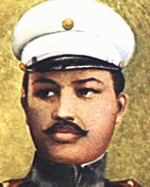Trivia about the “Parisian Life” by Juan Luna
“Parisian Life”, also known as “Interior d’un Cafe” was painted in c 1892 by Juan Luna. The oil on canvass painting, 22 inches long ~ and 31 inches in width, and now housed at the GSIS Museum of fA Art-Pasay City, features three Filipino patriots – Jose Rizal, Juan Luna, and Ariston Bautista Lin. It was given by Juan Luna to Ariston Bautista Lin who kept it in his Quiapo house, site of the Propaganda and Katipunan movements.
The Christie’s catalogue describes “Parisian Life” as the “best features of the artist’s work from the Paris period, testifying to his sensitivity and skill in capturing a fleeting moment of ordinary life, and imbuing it with personality and universal emotions.” At the center of the delicately painted masterpiece is a young and pretty woman languidly sitting on a sofa. The painting also captures three Filipino heroes in the advent of the revolution. In 1892, the patriots did not realize that they would change the course of Philippine history. Jose Rizal wrote the inspirational novels of Noli Me Tangere and EI Filibusterismo and became the most beloved Philippine national hero. Juan Luna painted award-winning paintings and was a member of the first Philippine diplomatic mission to the United States. Ariston Bautista Lin discovered paregoric, a medicine that stopped the onslaught of countrywide cholera epidemic at the turn of the century. He was also the financier of the Propaganda movement, Katipunan, Philippine Revolution and Philippine America War. The three patriots played pivotal roles in Philippine history.
The painting is the only one, among the hundreds of Juan Luna paintings wherein the master painter painted himself, as part of the painting’s narrative. The painting also illustrates the Impressionist attempts of Luna in color, perspective and theme at the height of 19th century Impressionist movement in France. Even after the demise of Luna, the painting was publicly exhibited and won a silver Medal in the 1904 St. Louis Exposition.
One interpretation claims the lady as the mirror image of the Philippine archipelago. Superimposition of the Philippine map’s mirror image on the lady highlights the following: the contour of Northern Luzon follows the same contour of the lady’s bodice; the distance between Infanta, Quezon and San Antonio, Zambales is exact to the small waistline of the lady ; all islands of Visayas and Mindanao are evenly spread out within the pink gown of the lady; the island of Palawan has exactly the same incline and shape as the arm of the lady; the mountain range that separates Surigao from Agusan and Davao is exact to the dark fold of the lady’s gown from north to south; the site of the birth of 1898 Philippine Independence, Kawit Cavite, is exact on the lady’s womb, site of a woman’s birthing; the site of the declaration of 1899 Constitution, Malolos, Bulacan, is exact on the navel of the lady. Constitution is the bloodline of the nation and the umbilical cord is the infant’s bloodline to his mother; and Cebu covers a knee of the lady. Cebu is the site of the first Christianization in the country.
Simply the interpretation contends the lady as our motherland. The motherland is awkwardly poised, disturbed with a blank stare, unsure whether to stand up or remain seated. Wrth this contention, it integrates cohesively other elements in the painting. ORDER FORM The three heroes are discussing the disturbed state of the motherland in 1892. It is the exact year when La Liga Filipina was formed (July 3); when the Katipunan was formed (July 7) and when Jose Rizal was banished to exile in Dapitan (July 7). The year 1892 was the eve of the Philippine Revolution. The newspaper L’Echo De Paris is folded behind the lady. The newspaper signifies the Cry of Bastille or French Revolution, inspiration of the Philippine Revolution. The French aspirations of Liberty, fraternity and Equality were identical to the longings of the Filipinos. Thus, the French revolution, the echo of Paris, figures clearly behind the disturbed state of Philippine motherland in 1892.
In acquiring the painting, the GSIS claims it has shown that it does not only insure the future of government employees and public properties but also the national treasures of the Filipino people. The “Parisian Life”, GSIS says, is an investment. A painting of such importance will not only appreciate intrinsically but also in monetary value, says GSIS President and General Manager Winston Garcia.

Recent Comments